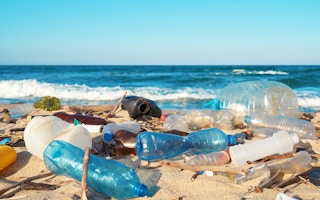Microplastics are a growing global concern. Due to their small size, these materials have the potential to spread throughout all parts of the environment, from mountains and oceans to drinking water, and are consumed unwittingly by humans.
To continue reading, subscribe to Eco‑Business.
There's something for everyone. We offer a range of subscription plans.
- Access our stories and receive our Insights Weekly newsletter with the free EB Member plan.
- Unlock unlimited access to our content and archive with EB Circle.
- Publish your content with EB Premium.
According to a study by World Wide Fund for Nature (WWF), we could be ingesting 5 grams of plastic—equivalent to the weight of a credit card—every week through the air we breathe and the food and water we consume.
With Southeast Asia facing water scarcity from climate change, an increase in human population over the years and poor water management, water contaminated with microplastics is an additional environmental issue for the region.
But despite the growing worldwide attention and ambitious goals to rid them from the environment, the impact of microplastics on human health is still unclear.
A report by the World Health Organization (WHO) on microplastics in drinking water concluded that the risk to human health from microplastics is low, as it currently stands, but more studies are needed.
As a result, the WHO urgently calls for more research in the field of microplastic pollution to develop a clear, reliable assessment framework for the exposure risk of microplastics and their potential impact on human health.
“
The lack of standardisation prevents researchers from… moving towards a consensus on whether microplastics present a threat to human health, making regulation difficult.
Developing standardised scientific methods to detect, identify, quantify, and suitably characterise microplastics across the globe, which are currently lacking, is the first step in responding to this call to action.
The chief scientific advisors of the European Union Commission have called for broader research into microplastic pollution, as the union is looking to regulate its production and usage for its continental population. Once armed with robust scientific understanding, regulations and concrete actions for microplastics can be designed.
Regulating a cross-border issue
It is important to recognise that microplastics represent a cross-border issue, requiring global cooperation and action. Disparate measures, often based on varied regional priorities on microplastics management, are in place in different regions around the world.
In Europe, even neighbouring countries like France and Germany have different approaches to managing microplastics.
France has banned the use of intentionally added microplastics in rinse-off cosmetic products, whereas Germany has thus far taken no action on banning microplastics in rinse-off cosmetic products, despite emphasising the need for global action to tackle microplastic pollution.
Asean countries have adopted the Bangkok Declaration, which is an integrated land-to-sea approach to prevent and reduce marine debris and enhance regional and international cooperation, including relevant policy dialogue and information sharing.
One consistent trait across every region is that more scientific research and cross-border access to standardised data is required to improve our understanding of microplastics and inform concrete, legally binding regulations.
Nevertheless, countries and agencies have moved ahead with restricting the addition of microplastics, such as Japan, which has passed a bill to reduce microparticles in its bid to tackle ocean pollution. The bill calls for manufacturers, especially personal care companies, to lower plastic particle emissions.
While this is a right step to curb the issue, standardised regulations and approaches to microplastics would help countries around the world tackle the issue more holistically.
So, what needs to happen?
Given the infancy and complexity of microplastics, it is unsurprising that there is a lack of standardised scientific methodologies for sampling, analysis and reporting of biological effects in the environment and humans.
The lack of standardisation prevents researchers from comparing these studies and moving towards a consensus on whether microplastics present a threat to human health, making regulation difficult.
It is easy to see the issue as insurmountable. But considering what is at stake, steps are being taken to address some aspects of the issue, for example, funding. More research than ever before is being coordinated in this area; the EU funding Program, Horizon 2020, allocated over €250 million to finance research and development in areas of direct relevance to microplastics.
In addition to funding, biotechnology companies, like Agilent, have developed the most sensitive technologies, which are able to identify and characterise microplastics at minuscule amounts, making the process more robust and easier to do than ever before.
It is only with the supporting technology and scientific rigour that research efforts will be able to uncover the true extent of the impact of microplastics.
Moving towards scientific uniformity
Currently, no globally harmonised testing standards for microplastics exist. However, standard development organisations are hard at work on standards, both on a regional and international level, such as the International Standard Organization (ISO), the European Committee for Standardization (CEN) and the American Society for Testing and Materials (ASTM International).
As the introduction of new global regulations will affect how both the public and private sectors deal with issues surrounding microplastics moving forward, it is crucial to ensure that all regulatory decisions are supported by premium scientific evidence with the highest integrity of data.
Given the potential impact on human health, it is essential that the scientific community standardises their research about microplastics to assist governments in making the right decisions, which will impact several stakeholders like consumers, manufacturers and retailers, among others.
Microplastics have spurred an era of huge public, governmental and private sector attention, but we are also in an era of cutting-edge detection and monitoring technology. These technologies can identify and quantify microplastics at greater levels of specificity and accuracy.
Such scientific advancements can improve our understanding of the impact of microplastics, as well as the development of much-needed regulations for a safe and clean world.
Tarun Anumol is the director of Global Environment & Food Applied Markets at United States-headquartered biotechnology company Agilent Technologies.











